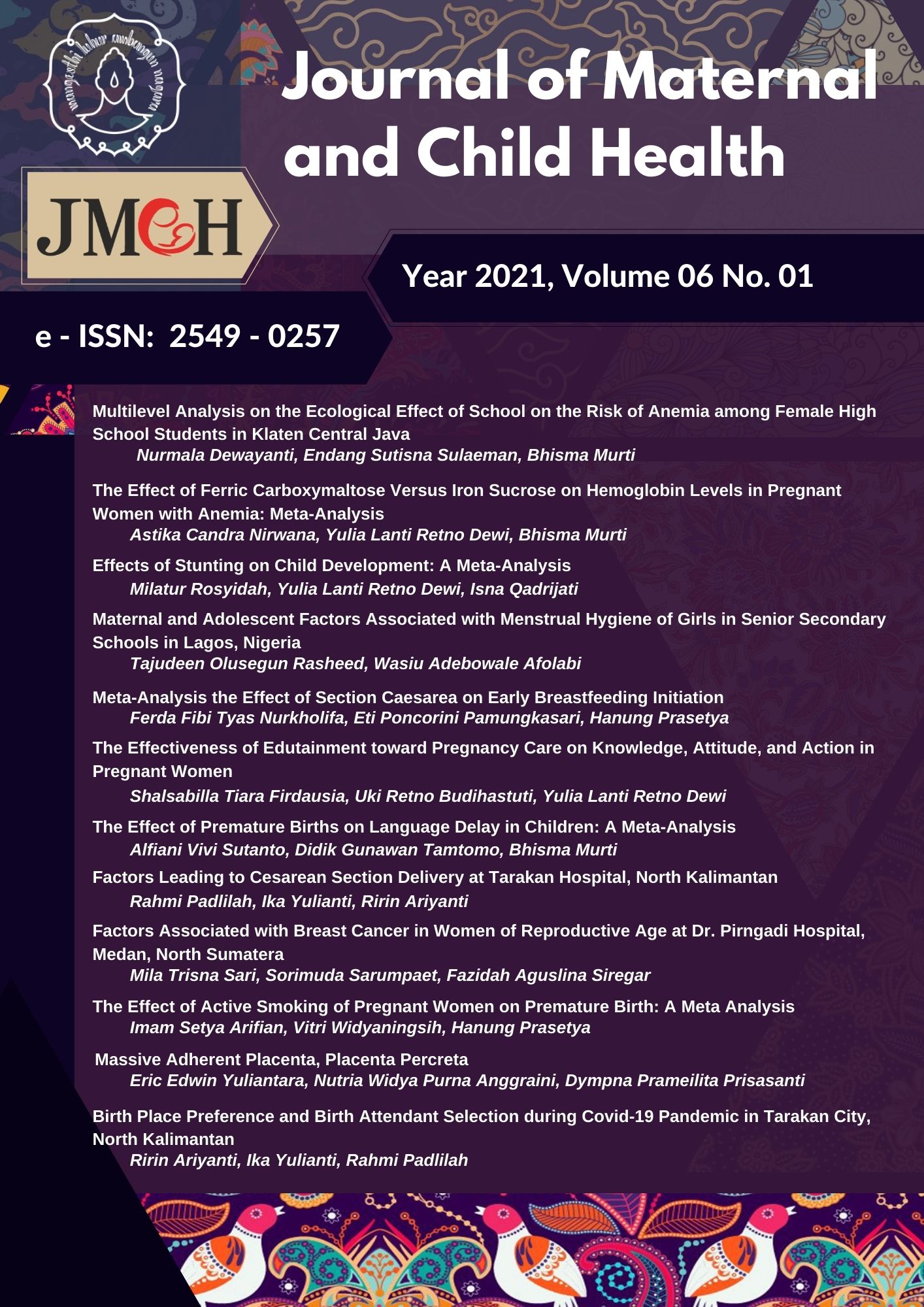Massive Adherent Placenta, Placenta Percreta
Abstract
Background: Adherent placentas including placenta accreta, increta and percreta are conditions where there is abnormal implanta
References
Belfort MA, Publication Committee, Society for Maternal-Fetal Medicine (2010). Placenta accreta. Am J Obstet Gynecol. 203(5):430-9. https://doi.org/10.1016/j.ajog.2010.09.013.
Berkley EM, Abuhamad AZ (2013). Prenatal diagnosis of placenta accreta. J Ultrasound Med. 32(8): 1345-50. https://doi.org/10.7863/jum.2008.27.9.1275.
Chong Y, Zhang A, Wang Y, Chen Y, Zhao Y (2018). An ultrasonic scoring system to predict the prognosis of placenta accrete: A prospective cohort study. Medicine (Baltimore). 97(35): e12111. https://dx.doi.org/10.1097%2FMD.0000000000012111.
Committee opinion (2012). Placenta accreta. Washington DC: The American College of Obstetricans and Gynecologists.
Comstock CH (2011). General obstetric sonography: prenatal diagnosis of placenta accreta. Dalam: Arthur CF, Eugene CT, Wesley L, Frank AM, Roberto JR. Sonography in obstetric an gynecology. Edisi ke-7. Tennesse.
Dagi TF (2005). The management of postoperative bleeding. Surg Clin North Am. 85(6):1191-213. https://doi.org/10.1016/j.suc.2005.10.013.
Dola C, Longo S (2006). Diagnosis and safe management of placenta previa. OBG Manag. 18(10):77-95.
Dwyer BK, Belogolovkin V, Tran L, Rao A, Carroll I, Barth R, Chitkara U (2008). Prenatal diagnosis of placenta accreta: sonography or magnetic resonance imaging?. J Ultrasound Med. 27(9): 1275-81. https://doi.org/10.7863/jum.2008.27.9.1275.
Garmi G, Salim R (2012). Epidemiology, etiology, diagnosis, and management of placenta accreta. Obstet Gynecol Int. 873929. https://doi.org/10.1155/2012/873929.
Liapis K, Tasis N, Tsouknidas I, Tsakotos G, Skandalakis P, Vlasis K, Filippou D (2020). Anatomic variations of the uterine artery. Review of the literature and their clinical significance. Turk J Obstet Gynecol. 17(1): 58
Mascarello KC, Horta BL, Silveira MF (2017). Maternal complications and cesarean section without indication: systematic review and meta-analysis. Rev Saude Publica. 51: 105. https://dx.doi.org/10.11606%2FS1518-8787.2017051000389.
McGraw H (2010). Obsterical complications: obstetrics haemorrhage. Dalam: Cunningham, Leveno, Bloom, Hauth, Rouse, Spong. Williams obstetrics. Edisi ke-23. Texas.
Osol G, Mandala M (2009). Maternal Uterine vascular remodeling during pregnancy. Physiology (Bethesda). 24: 58
Palacios-Jaraquemada JM, Fiorillo A, Hamer J, Mart
Robinson BK, Grobman WA (2010). Effectiveness of timing strategies for delivery of individuals with placenta previa and accreta. Obstetr Gynecol. 116(4):835-42. https://doi.org/10.10-97/aog.0b013e3181f3588d.
Sivasankar C (2012). Perioperative management of undiagnosed placenta percreta: case report and management strategies. Int J Womens Health. 4: 451-4. https://doi.org/10.2147/ijwh.s35104.
Tantbirojn P, Crum CP, Parast MM (2008). Pathophysiology of placenta creta: the role of decidua and extravillous trophoblast. Placenta. 29(7):639-45. https://doi.org/10.1016/j.placenta.2008.04.008.
Volochovi? J, Rama
Warshak CR, Ramos GA, Eskander R (2010). Effect of predelivery diagnosis in 99 consecutive cases of placenta accreta. Obstet Gynecol. 115(1):65-9.https://doi.org/10.1097/aog.0b013e3181c4f12a.




